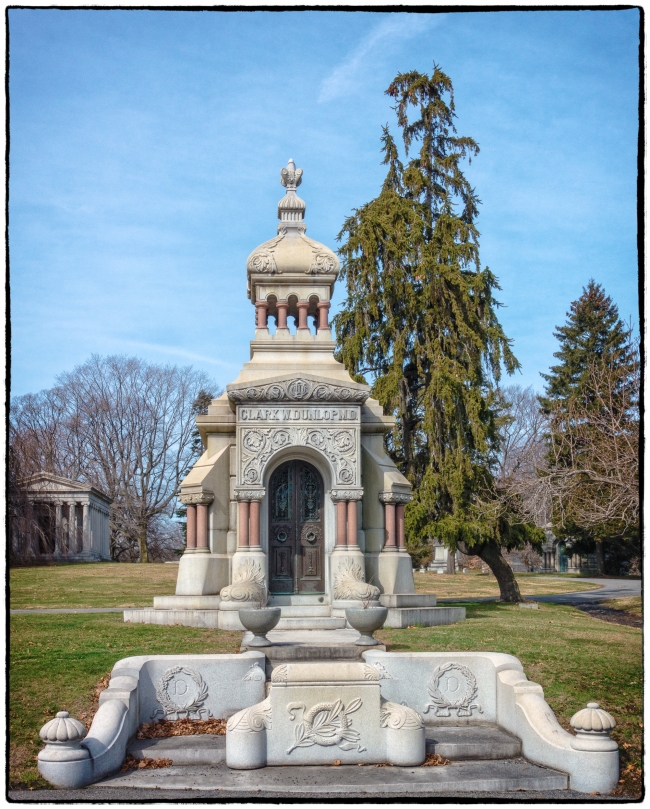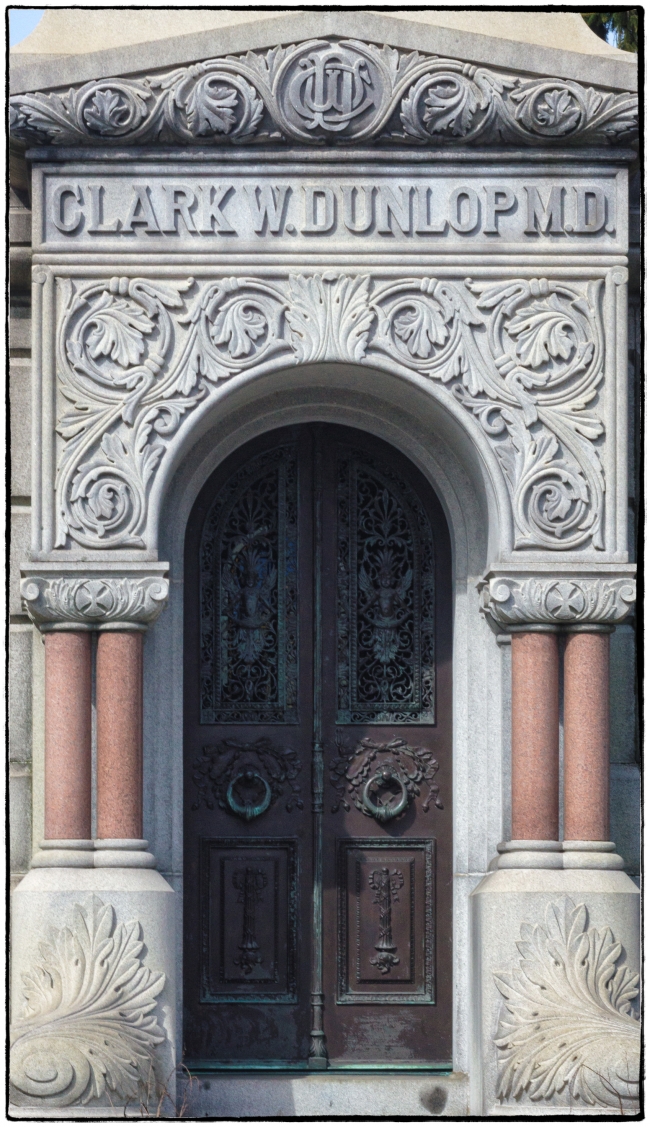Dr. Clark Dunlop was financially successful, but died in sad circumstances. He made his fortune from a medical manual (Dr. Dunlops Family Practice), and a number of patent medicines including Dr. Dunlops King of Pain, and Dr. Dunlop’s Cascara Compound (a laxative). He made enough money to be able to build this exotic mausoleum. According to Douglas Keister on Mausoleums.com:
The mausoleum, which is more of a confection than a piece of architecture, was built by prominent mausoleum builders C. E. Tayntor & Company. The company quarried granite in Maine and Vermont and had offices in New York. It is difficult to put the Dunlop mausoleum into any specific architectural category. It has elements of Islamic and Byzantine and Classical Revival architecture. Then there is the curious feathery plinth flanking the steps.
The stylized feathers are most likely an homage to the Dunlops’ pet parrot (name unknown). The skeleton of the parrot reposes on a fabric bed in a glass-topped mini-casket inside a steel box that rests atop a marble shelf inside the mausoleum. Most cemeteries have rather strict regulations that prohibit pet burials, but somehow the parrot slipped under the radar. According to a tag attached to the parrot’s eternal home it expired in March, 1921 after being in the family for 30 years. It is unknown if the parrot died peacefully. Dr. Clark W. Dunlop certainly did not.
When he was declared mentally incompetent in 1907 this caused considerable strife among more distant family members (he and his wife had no children) who wanted a piece of his fortune. At the time he was being treated (unsuccessfully as it turned out) using “Magic Boots”. Again from Keister:
The late nineteenth and early twentieth century was a time of patent medicines, remedies and tortuous-looking medical contraptions. Enter shoemaker and now self-proclaimed “Professor” Matthew Hilgert who invented “magic boots”. Holgert claimed that his footwear restored balance in the body by starting from the bottom up (the feet) using special lasts to curve the arch of the foot. He also claimed he added secret chemicals to the boots that were absorbed into the body. His “magic mechanico-physiological” boots were advertised to cure all physical ailments. Hilgert claimed to have numerous satisfied customers including celebrity endorsers from baseball team owners to businessmen to Bishops. At the height of their popularity the boots reportedly sold for $1000 to $5000. Understandably most purchasers of the boots were the well-to-do. Hilgert claimed that his magic boots could cure “locomotor ataxia, paralysis, hip joint disease, sciatica, rheumatism, gout, neuritis, neuralgia, ticdoloureux, not to mention nervous prostration”.
He returned home and died not long after in 1908. His wife lived to a ripe old age (into her 90s) and the parrot apparently continued on until its death in 1921.
For some fascinating pictures of he interior of the tomb, including two of the skeletal remains of the parrot see: Society Adventures: The Entombed Parrot of Woodlawn Cemetery.
In the background you can just make out the impressive mausoleum of famous “robber baron“, Jay Gould. This too has an intriguing story associated with it. According to Keister on Mausoleums.com
Interestingly, Jay Gould’s crypt is soldered closed. Apparently the Gould family didn’t want a repeat of an incident that occurred in 1876 where the body of another millionaire, A.J. Stewart, was stolen from St. Mark’s Cemetery in Manhattan, and his remains were held for ransom. An undisclosed amount of money was paid by Mrs. Stewart for the return of what was presumed to be her husband, (embalming wasn’t an exact science in the 1870’s). Accounts of the day suggest that some of Gould’s enemies on Wall Street had the casket sealed so there was no way he could ever show up to wreak havoc again. The London Times obit summed up Gould’s life best when it declared, “All honor to the greatest money maker of any age or clime. He was less a man than a machine for churning wealth. Napoleon’s combinations were never vaster…. It will be impossible to explain one phase of civilization without a frequent mention of his name”.
Detail of facade.


